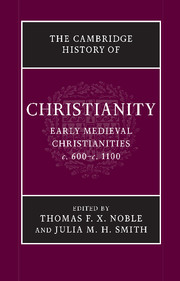Book contents
- Frontmatter
- Introduction: Christendom, c. 600
- Part I Foundations: Peoples, Places, and Traditions
- Part II Christianity in Confrontation
- Part III Christianity in the Social and Political Order
- Part IV Christianity as Lived Experience
- Part V Christianity: Books and Ideas
- 24 Visions of God
- 25 Orthodoxy and deviance
- 26 Making sense of the Bible
- 27 The Christian book in medieval Byzantium
- 28 Saints and their cults
- 29 Last Things
- Conclusion: Christendom, c. 1100
- Bibliographies
- Index
- References
25 - Orthodoxy and deviance
from Part V - Christianity: Books and Ideas
Published online by Cambridge University Press: 28 March 2010
- Frontmatter
- Introduction: Christendom, c. 600
- Part I Foundations: Peoples, Places, and Traditions
- Part II Christianity in Confrontation
- Part III Christianity in the Social and Political Order
- Part IV Christianity as Lived Experience
- Part V Christianity: Books and Ideas
- 24 Visions of God
- 25 Orthodoxy and deviance
- 26 Making sense of the Bible
- 27 The Christian book in medieval Byzantium
- 28 Saints and their cults
- 29 Last Things
- Conclusion: Christendom, c. 1100
- Bibliographies
- Index
- References
Summary
The period covered by this volume, c. 600–c. 1100, stands alone in Christian history as an age in which there were very few major struggles over definitions of orthodoxy. This is not to say that there were no disputes among learned churchmen about points of doctrine; indeed, there were some very interesting controversies revolving around familiar problems of theology and practice. Yet none of these disputes ended in a new doctrinal definition that was passed on to future centuries as authoritative, like the great theological syntheses created in the patristic and scholastic ages. Nor could one say that there were no early medieval movements of popular piety, or lay people who followed charismatic religious leaders. This period provides several examples of this sort of challenge to the ecclesiastical orthodoxy, but none, at least until the eleventh century, ended up changing the shape of the church of the time like the great movements of lay piety in the later Middle Ages. Nor did early medieval conflicts over theological issues have the geographical and chronological scope of later disputes; many, indeed, were quite localized and fleeting. Nevertheless, the theological issues that came to the fore in the early Middle Ages are important as windows on the development of theology in an especially fluid period that mediated between the age of the fathers and the towering syntheses of later medieval theology. This chapter, consequently, has a double task: to summarize the disputes that did arise among Christians from approximately 600 to 1100, and to suggest some reasons for why the dynamic of early medieval heresy and orthodoxy is so strikingly different from the periods that came before and after.
- Type
- Chapter
- Information
- The Cambridge History of Christianity , pp. 510 - 530Publisher: Cambridge University PressPrint publication year: 2008
References
- 1
- Cited by



